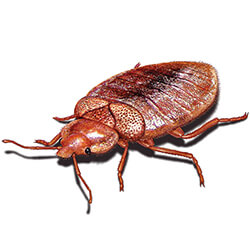Identification
- Colour Reddish brown, with abdomen darker as blood is digested
- Size Adults are approximately 4 to 5 mm long, size of an apple seed
- Description Bed bugs are an oval shape, they have a flattened body, two antennae and six legs

How to identify bed bugs?
Bed bugs are an oval shape and are up to 4-5 mm long when fully grown. Adult bed bugs have a flattened body and their skin colour is either rust brown or a deeper red brown.
Due to the flattened body of a bed bug they can easily hide in small places such as baseboards, cracks in floors, under carpets, behind loose wallpaper, bed frames, sofas, behind picture frames and many other places which makes them very difficult to detect. They tend to stay together and large infestations will give off a sweet but unpleasant smell.
What are some key signs of bed bugs?
If you suspect bed bugs, or want to be proactive, look for live or dead bugs or the skins they can leave behind when they are molting. After feeding, bed bugs will regularly leave behind small spots of reddish-black fecal matter on your bedding, mattress or box springs. They will lay their eggs (1/32″ to 1/8″ in size) in dark crevices near feeding areas.
Bed bug bites can also go unnoticed, and are even often misdiagnosed, making detection that much more difficult. Discover more answers to bed bug questions here.
Bed bugs spread
Once established, bed bugs tend to stay put but can spread due to any of the following;
- Being disturbed (i.e. disassembling furniture or incorrect pesticide application)
- A food shortage (i.e. no host) may cause them to migrate to neighbouring rooms
- A shortage of harbourage spaces may cause them to migrate to neighbouring rooms
- Infested furniture moved down a hall, or passed on to others
- Vacuum cleaners used for multiple rooms
- Commercial laundry machines
What to do if traces of bed bugs are found?
Do not
- Disturb the room further. Leaving the “scene” untouched will help Orkin Canada diagnose the problem.
- Take any items out of the room. Doing so will only help the bed bugs spread.
Do
- Stop using the room and “quarantine” it
- If the room is occupied, work with management to move guests to a new room
- Contact a professional pest control company immediately in order to inspect the infested room and/or pre-treat rooms to which any guests might be moved. In British Columbia you can only pre-treat when evidence of an infestation is found.
How can I prevent bed bug infestation?
Look for live or dead bugs or their skins, Check beds for red spots of fecal matter, Clean and vacuum bedrooms regularly, Protect mattresses and boxsprings with certified bed bug encasements, Use light coloured sheets to spot stains, Check all furniture near sleeping areas, Look around seams, crevices, and folds, Seal cracks in walls, trim, and bed frames.
Since bed bugs are such good hitchhikers and often hide in hard to reach areas the best way to truly rid yourself of bed bugs is often professional pest control. Orkin Canada uses specially trained bed bug dogs, to detect anywhere live bed bugs and their eggs are hiding – and uses customized control strategies to make sure they’re gone for good.
Habitat, Diet, and Behaviour
What is the lifecycle of a bed bug?
Bed bugs undergo gradual metamorphosis (egg, nymph, adult). Nymphs are smaller versions of the adults and will go through several molts until fully grown.
Females lay 200 to 500 eggs in her lifetime, 10 to 50 at a time, on rough surfaces. Eggs then hatch within 6 to 17 days, with adult bedbugs having the ability to survive over 1 year without feeding.
Commonly Asked Questions
Why do I have bed bugs?
Bed bugs are seeing a resurgence in Canada and even the cleanest of homes can fall victim to these painful pests. At night, bed bugs feed on sleeping humans, but by day, they hide in dark undisturbed areas like inside furniture, baseboards, floorboards, carpets, and even wallpaper.
Bed bugs are attracted to the carbon dioxide and warmth that humans emit, which makes them particularly drawn to multi-unit buildings with lots of turnover like hotels or rental apartments, where they are often brought in on luggage or used furniture.
Bed bugs do not cling to people but they are notorious hitch hikers and can hide in our belongings (i.e. suitcase, purse, laptop bags). From there they can be introduced into a home, hotel, office, hospital, or any other building as well as modes of transportation. Sanitation is not a factor in whether or not you get bed bugs.
They are known to travel more than six metres from hiding in order to feed, but generally hide within two metres of their host, in large infestations that give off a sweet but unpleasant smell.
Why are bed bugs back?
Bed bugs never really left. They are common in many nations around the world. We are seeing a resurgence in North America for several reasons including a reduced use of pesticides, the use of second hand furniture and increased international travel as bed bugs are notorious hitch hikers.
The combination of re-introduction, increased international travel and the fact that pest control professionals no longer use older pesticides (such as DDT, Chlordane and Lindane) means that bed bugs have been able to stage a resurgence and become a very serious pest in the 21st century. They have a unique ability to hide and due to their ability to spread, new inspection and control methods must be far more thorough and extensive than with many other pests.
Bed bugs are parasitic insects that live near their hosts. Since they feed on humans (their hosts) their habitats include houses, hotels, or any property that we frequent. All they require is a protected area in close proximity to a feeding source. Bed bugs bite people when they are sleeping usually on exposed skin.
When looking for a meal bed bugs can move very quickly to feed and then back into hiding after their meal. Bed bugs have been known to travel over 20 feet from hiding in order to feed but will generally hide within 3-6 feet of their host. Unless you know specifically how to look for bed bugs these pests can be easily overlooked.
How worried should I be about bed bugs?
You may find red spots of fecal matter on your bed after being bitten by bed bugs, but it can be maddeningly difficult to detect where the bugs are actually hiding.
Bed bugs multiply quickly, with females laying up to 500 eggs in her lifetime. In just six months, a few of these pests can turn into a full-on infestation of more than 13,000 bed bugs. Adults can also survive for a year without feeding, so even if you leave, they might not.
100% Satisfaction or Money Back Guarantee
Resolving your pest problem is our #1 priority. If re-treatment is required, we'll provide immediate services at no extra cost. If your expectations are not met, we guarantee a full refund of your service payment.
Remove pests from your home, and stop them from coming back
We work hard to listen, understand and assess your unique situation. Request a free, no-obligation estimate today for a customized pest program that fits your needs.
Request a Free Home EstimateRequest a Free Business Consultation

